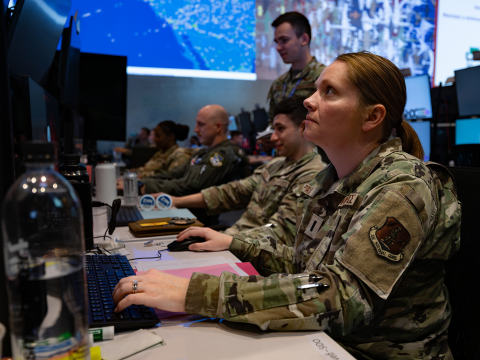Smart Strategic Deterrence Leverages Digital Engineering
The Air Force is in the process of developing a successor to the LGM-30G Minuteman III intercontinental ballistic missile (ICBM) known as the Ground-Based Strategic Deterrent (GBSD). The GBSD is the land-based component of the United States’ nuclear deterrence triad, which, along with ballistic missile submarines and the aircraft bomber fleet, serves as the backbone of our national security, according to the Defense Department.
The service also is working on a next-generation airborne missile control system that can launch both Minuteman III as well as GBSD missiles when the latter is ready for deployment in the late 2020s as expected.
Next year, the Air Force plans to select one company—either Boeing or Northrop Grumman—to engineer and manufacture the GBSD, slated to be in use for decades to come. Currently, the two companies are working under separate technology maturation and risk reduction contracts that run through August 2020.
Given the changing geopolitical dynamics of the world, the United States needs a stellar GBSD, said Gen. Timothy M. Ray, USAF, commander, Air Force Global Strike Command; and Commander, Air Forces Strategic Command - Air, U.S. Strategic Command, Barksdale Air Force Base, Louisiana.
Speaking yesterday at a Defense Writers Group event at The George Washington University, Gen. Ray outlined the service’s expectations of the GBSD. “Going forward, what the United States needs most right now is the right long-range precision strike force that is safe, secure, reliable, effective and affordable, the general asserted. “We talk about affordability right now, and my view is we can't spend our way out of this. We're going to have to be really smart about it."
Part of that means leveraging digital engineering as much as possible. “You have to have the ability to get stable, good technology on the ramp and out in the field as soon as possible and build in block upgrades,” he said. “And if you've designed in modularity or easy, rapid adaptability, then you give yourself a more affordable baseline."
Moreover, the Air Force has to drive a competitive environment “because the big price tag of all these weapons systems does really plague the sustainment,” Gen. Ray noted. “So what we've seen in particular with the GBSD, is that we’ve actually had to ask people to come look at this. And I will tell you that Dr. [Will] Roper believes that this is the best acquisition program.” Roper, the assistant secretary of the Air Force for Acquisition, Technology and Logistics, is the service’s acquisition executive.
The general contended that “the quality of thinking and leveraging of digital modeling and engineering” has propelled the development of the weapon system forward. “Typically by this stage you would be on your second design cycle. We're past nine. And the insights are incredible."
Those advancements also will help in the long run as far as costs, he suggested. “So while you may see a slight change in the service cost position here, which is based on the infrastructure, my prediction is that when we do get into source selection, you'll see the service cost position come down. Our estimates are in the billions of savings.”
At his post for about a year, Gen. Ray said his experiences as a three-star general overseeing the Air Force’s operational duties in Europe and Africa and later as the deputy of the European Command have informed his current efforts and provided a clear view of the changing world and the need for defenses such as the GBSD.
“I was there for a year and a half working through the transition of what was a peacetime engagement command to a command dealing with great power competition,” he explained. “I got to see what was going on throughout the Med [Mediterranean region] and the Middle East. We dealt with Turkey and Israel, and certainly the Russian dimension of how that played after the Crimean and Eastern invasions. That challenge shaped the entire year… [and it was a] strategic shift away from what was a counterterrorism-focused world that we had been living in for over 15 years, to really putting [our] minds around the idea of big power competition.”




Comments